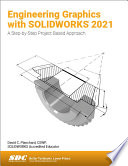Product desciption
Engineering Graphics With Solidworks 2021 Stepbystep Project Based Approach Utilizing 3d Solid Modeling David C Planchard by David C. Planchard 9781630574079, 1630574074 instant download after payment.
Engineering Graphics with SOLIDWORKS 2021 is written to assist students, designers, engineers and professionals who are new to SOLIDWORKS. The book combines the fundamentals of engineering graphics and dimensioning practices with a step-by-step project based approach to learning SOLIDWORKS. The book is divided into four sections with 11 Chapters. Chapters 1 - 3: Explore the history of engineering graphics, manual sketching techniques, orthographic projection, Third vs. First angle projection, multi-view drawings, dimensioning practices (ASME Y14.5-2009 standard), line type, fit type, tolerance, fasteners in general, general thread notes and the history of CAD leading to the development of SOLIDWORKS. Chapters 4 - 9: Comprehend the SOLIDWORKS User Interface and CommandManager, Document and System properties, simple machine parts, simple and complex assemblies, proper design intent, design tables, configurations, multi-sheet, multi-view drawings, BOMs, and Revision tables using basic and advanced features. Follow the step-by-step instructions in over 80 activities to develop eight parts, four sub-assemblies, three drawings and six document templates. Chapter 10: Prepare for the Certified SOLIDWORKS Associate (CSWA) exam. Understand the curriculum and categories of the CSWA exam and the required model knowledge needed to successfully take the exam. Chapter 11: Provide a basic understanding between Additive vs. Subtractive manufacturing. Discuss Fused Filament Fabrication (FFF), STereoLithography (SLA), and Selective Laser Sintering (SLS) printer technology. Select suitable filament material. Comprehend 3D printer terminology. Knowledge of preparing, saving, and printing a model on a Fused Filament Fabrication 3D printer. Information on the Certified SOLIDWORKS Additive Manufacturing (CSWA-AM) exam. Review individual features, commands, and tools using SOLIDWORKS Help. The chapter exercises analyze and examine usage competencies based on the chapter objectives. The book is designed to complement the SOLIDWORKS Tutorials located in the SOLIDWORKS Help menu. Desired outcomes and usage competencies are listed for each project. Know your objectives up front. Follow the step-by step procedures to achieve your design goals. Work between multiple documents, features, commands, and properties that represent how engineers and designers utilize SOLIDWORKS in industry. The author developed the industry scenarios by combining his own industry experience with the knowledge of engineers, department managers, vendors and manufacturers.


